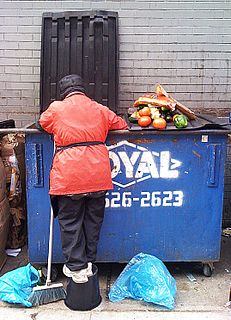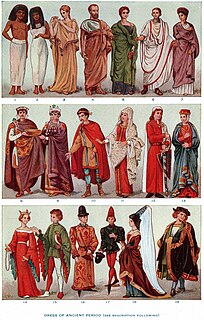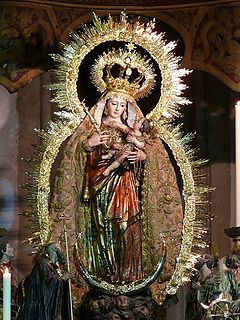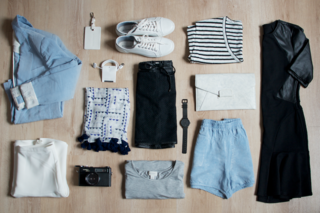Costume is the distinctive style of dress or cosmetic of an individual or group that reflects class, gender, profession, ethnicity, nationality, activity or epoch. In short costume is a cultural visual of the people.

Dumpster diving is salvaging from large commercial, residential, industrial and construction containers for unused items discarded by their owners but deemed useful to the picker. It is not confined to dumpsters and skips specifically and may cover standard household waste containers, curb sides, landfills or small dumps.

Clothing are items worn on the body. Typically, clothing is made of fabrics or textiles, but over time it has included garments made from animal skin and other thin sheets of materials and natural products found in the environment, put together. The wearing of clothing is mostly restricted to human beings and is a feature of all human societies. The amount and type of clothing worn depends on gender, body type, social factors, and geographic considerations. Garments cover the body, footwear covers the feet, gloves cover the hands, while hats and headgear cover the head. Eyewear and jewelry are not generally considered items of clothing, but play an important role in fashion and clothing as costume.

A closet is an enclosed space, with a door, used for storage, particularly that of clothes. Fitted closets are built into the walls of the house so that they take up no apparent space in the room. Closets are often built under stairs, thereby using awkward space that would otherwise go unused.
Drill is stout durable cotton fabric with a strong bias (diagonal) in the weave. It can be used unbleached, although it is more often bleached or dyed.

A wardrobe malfunction is a clothing failure that accidentally or intentionally exposes a person's intimate parts. It is different from deliberate incidents of indecent exposure or public flashing. Justin Timberlake first used the term when apologizing for the Super Bowl XXXVIII halftime show controversy during the 2004 Grammy Awards. The phrase "wardrobe malfunction" was in turn used by the media to refer to the incident and entered pop culture. There was a long history of such incidents before the term was coined and it has since become common.

A bedroom is a room situated within a residential or accommodation unit characterised by its usage for sleeping. A typical western bedroom contains as bedroom furniture one or two beds, a clothes closet, and bedside table and dressing table, both of which usually contain drawers. Except in bungalows, ranch style homes, or one-storey motels, bedrooms are usually on one of the floors of a dwelling that is above ground level.

Zara SA, stylized as ZARA, is a Spanish apparel retailer based in Arteixo, A Coruña, Galicia, Spain. The company specializes in fast fashion, and products include clothing, accessories, shoes, swimwear, beauty, and perfumes. It is the largest company in the Inditex group, the world's largest apparel retailer. Zara as of 2017 manages up to 20 clothing collections a year.

Cufflinks are items of jewelry that are used to secure the cuffs of dress shirts. Cufflinks can be manufactured from a variety of different materials, such as glass, stone, leather, metal, precious metal or combinations of these. Securing of the cufflinks is usually achieved via toggles or reverses based on the design of the front section, which can be folded into position. There are also variants with chains or a rigid, bent rear section. The front sections of the cufflinks can be decorated with gemstones, inlays, inset material or enamel and designed in two or three-dimensional forms.

The term cupboard was originally used to describe an open-shelved side table for displaying dishware, more specifically plates, cups and saucers. These open cupboards typically had between one and three display tiers, and at the time, a drawer or multiple drawers fitted to them. The word cupboard gradually came to mean furniture for enclosing dishware or grocery items that are stored in a home.

A tippet is a piece of clothing worn over the shoulders in the shape of a scarf or cape. Tippets evolved in the fourteenth century from long sleeves and typically had one end hanging down to the knees. A tippet could also be the long, narrow, streamer-like strips of fabric worn as an armband just above the elbow, that hung gracefully to the knee or even the ground. In later fashion, a tippet is often any scarf-like wrap, usually made of fur, such as the sixteenth-century zibellino or the fur-lined capelets worn in the mid-18th century.

A santo is a piece of one of various religious art forms found in Spain and areas that were colonies of the Kingdom of Spain, consisting of wooden or ivory statues that depict various saints, angels, or Marian titles, or one of the personages of the Holy Trinity. A santero is a craftsperson who makes the image. Some santos which have gained greater public devotion among the faithful have also merited papal approval through canonical coronations. Santos remain a living tradition of religious iconography and folk art in Mexico, the Philippines, Puerto Rico and some other Caribbean islands, South and Central America, and the Southwestern United States, especially New Mexico.

The King's Wardrobe, together with the Chamber, made up the personal part of medieval English government known as the King's household. Originally the room where the king's clothes, armour, and treasure were stored, the term was expanded to describe both its contents and the department of clerks who ran it. Early in the reign of Henry III the Wardrobe emerged out of the fragmentation of the Curia Regis to become the chief administrative and accounting department of the Household. The Wardrobe received regular block grants from the Exchequer for much of its history; in addition, however, the wardrobe treasure of gold and jewels enabled the king to make secret and rapid payments to fund his diplomatic and military operations, and for a time, in the 13th-14th centuries, it eclipsed the Exchequer as the chief spending department of central government.
A wardrobe or armoire is a standing closet used for storing clothes. The earliest wardrobe was a chest, and it was not until some degree of luxury was attained in regal palaces and the castles of powerful nobles that separate accommodation was provided for the apparel of the great. The name of wardrobe was then given to a room in which the wall-space was filled with closets and lockers, the drawer being a comparatively modern invention. From these cupboards and lockers the modern wardrobe, with its hanging spaces, sliding shelves and drawers, evolved slowly.
Sustainable fashion is a movement and process of fostering change to fashion products and the fashion system towards greater ecological integrity and social justice. Sustainable fashion concerns more than just addressing fashion textiles or products. It addresses the entire manner in which clothing is produced, who produces it, and how long the life span of a product is before it reaches the landfill. This sustainable movement combats the large carbon footprint that the fashion industry and fast fashion have created by reducing greenhouse gas emissions. Reducing the environmental impact of fashion can combat air pollution, water pollution and overall climate change that could possibly prevent millions of premature deaths over the next century.

Capsule wardrobe is a term used in American publications as early as the 1940s to denote a small collection of garments designed to be worn together which harmonized in color and line. The term capsule wardrobe was revived by Susie Faux, the owner of a London boutique called "Wardrobe" in the 1970s. According to Faux, a capsule wardrobe is a collection of a few essential items of clothing that do not go out of fashion, such as skirts, trousers, and coats, which can then be augmented with seasonal pieces. This idea was popularised by American designer Donna Karan, who, in 1985, released an influential capsule collection of seven interchangeable work-wear pieces.
Return fraud is the act of defrauding a retail store by means of the return process. There are various ways in which this crime is committed. For example, the offender may return stolen merchandise to secure cash, or steal receipts or receipt tape to enable a falsified return, or to use somebody else's receipt to try to return an item picked up from a store shelf. Return abuse is a form of "friendly fraud" where someone purchases products without intending to keep them. Perhaps the best known form of this abuse is "wardrobing" or "free renting" – in which the person makes a purchase, uses the product(s), and then returns the merchandise.

In retail, a product return is the process of a customer taking previously purchased merchandise back to the retailer, and in turn receiving a refund in the original form of payment, exchange for another item, or a store credit.
Since the show's premiere, there have been a number of adventure/rhythm video games based on the Disney Channel show, Hannah Montana and the film. All the games were published by Buena Vista Games / Disney Interactive Studios.

Vinted is an online marketplace based in Lithuania for buying, selling and exchanging new or secondhand items, mainly clothing and accessories.













